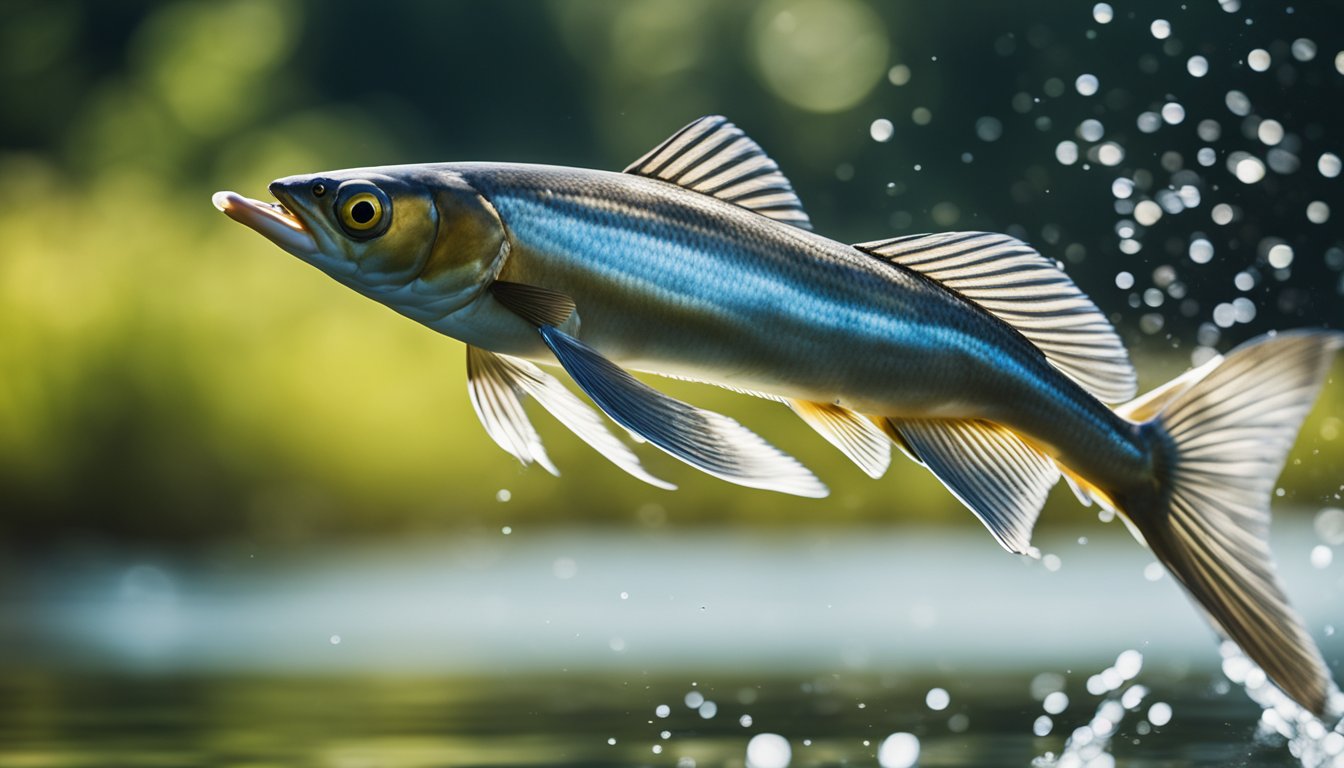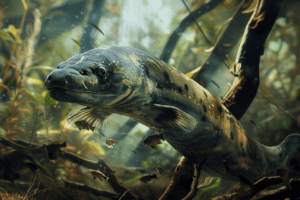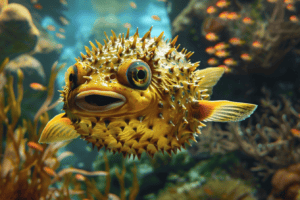The ocean is full of fascinating creatures, from the tiniest plankton to the largest whales.
But have you ever heard of a fish that can fly through the air?
It may sound like something out of a fairy tale, but flying fish are real, and they’re an incredible sight to behold.

Flying fish are found in oceans all around the world, from the warm waters of the tropics to the chilly seas near the poles.
These fish have a unique adaptation that allows them to leap out of the water and glide through the air for distances of up to 200 meters.
This incredible ability helps them escape from predators like dolphins and tuna, as well as catch prey like plankton and small fish.
Despite their name, flying fish don’t actually fly like birds or bats.
Instead, they use their powerful tails to propel themselves out of the water, and then spread their fins to catch the wind and glide through the air.
Some species of flying fish can even change direction mid-flight, using their fins to steer and avoid obstacles.
With their sleek, streamlined bodies and shimmering scales, flying fish are truly a marvel of the natural world.
The Anatomy of Flight

Flying fish are unique creatures that have evolved to be able to glide through the air for long distances, allowing them to escape predators in the water.
To understand how they are able to achieve this incredible feat, it is important to examine their anatomy and the adaptations that have made it possible.
Fins and Scales
One of the key adaptations that allows flying fish to take to the air is their specially adapted fins.
Their pectoral fins, which are located near the head, are much larger than those of other fish.
These fins act like wings, providing lift and allowing the fish to glide through the air.
Additionally, their scales are more aerodynamic than those of other fish, reducing drag and allowing for smoother flight.
Muscular Power
Another important factor in the flight of flying fish is their muscular power.
Flying fish are able to generate a lot of speed underwater, which allows them to launch themselves into the air.
Once in the air, they use their powerful tail muscles to maintain their speed and altitude.
This requires a lot of energy, which is why flying fish are known for their impressive stamina and endurance.
Overall, the anatomy of flying fish is a remarkable example of adaptation and evolution.
By studying their unique features, we can gain a greater appreciation for the diversity of life on our planet and the incredible ways in which organisms have adapted to survive in their environments.
Evolutionary Wonders

Natural Selection
The flying fish is an incredible creature that has evolved over millions of years to survive in its environment.
Through the process of natural selection, these fish have developed the ability to leap out of the water and glide through the air to escape predators.
This unique adaptation has allowed them to thrive in the open ocean, where they face many challenges.
Natural selection is the process by which certain traits become more common in a population over time because they provide a survival advantage.
In the case of the flying fish, those with the ability to leap and glide were better able to evade predators and find food.
As a result, this trait became more common in the population over time.
Adaptation Over Time
Over many generations, the flying fish has continued to adapt to its environment.
Its body shape has become more streamlined, allowing it to move more efficiently through the water and air.
Its fins have become larger and more powerful, providing greater lift and control during flight.
Its eyes have also evolved to see both above and below the water, helping it to spot predators and prey.
These adaptations have allowed the flying fish to become one of the most successful species in the open ocean.
They are able to travel long distances, find food, and avoid predators with incredible speed and agility.
Their ability to leap and glide through the air is truly remarkable and a testament to the power of evolution.
Fun Fact: The longest recorded flight by a flying fish was over 1,300 feet! That’s longer than four football fields!
Predators and Prey
Flying fish are not immune to predators, and they have developed a range of escape mechanisms to avoid becoming prey.
Some of the predators that prey on flying fish include birds, dolphins, and larger fish.
Escape Mechanisms
When threatened, flying fish can leap out of the water and glide through the air for distances of up to 200 meters.
This allows them to escape predators that are chasing them from below.
Flying fish can also use their pectoral fins to generate a burst of speed, allowing them to escape danger quickly.
Hunting Techniques
Predators have also developed their own hunting techniques to catch flying fish.
For example, dolphins have been known to create a wall of water that forces flying fish to leap out of the water, making them easier to catch.
Birds, on the other hand, use their keen eyesight to spot flying fish from above and then dive down to catch them.
Despite the risks, flying fish are an important part of the marine food chain.
They are a source of food for many predators, and their populations help to maintain the balance of the marine ecosystem.
As such, it is important to protect these amazing creatures and their habitats.
Habitats and Distribution

Flying fish are found in all the major oceans of the world, but they are most abundant in the warm waters of the Atlantic, Pacific, and Indian Oceans.
They are commonly found near the surface of the water, where they can easily take off and glide through the air to escape predators.
Flying fish are known to inhabit a variety of marine environments, including coral reefs, open ocean, and coastal areas.
They prefer warm waters with a temperature range of 20-30°C, and they are often found in areas with strong currents and waves.
These incredible creatures can be found in large schools, sometimes numbering in the thousands, and they are known to migrate long distances in search of food and suitable breeding grounds.
Some species of flying fish are found only in specific regions, such as the Exocoetidae family, which is found in the tropical and subtropical waters of the world’s oceans.
Fun fact: The largest species of flying fish, the Cheilopogon pinnatibarbatus, can grow up to 18 inches in length and weigh up to 1.5 pounds!
Frequently Asked Questions

What unique adaptations help flying fish escape predators?
Flying fish have several unique adaptations that help them escape predators.
One of the most notable is their ability to leap out of the water and glide through the air.
They have large, wing-like pectoral fins that they can spread out to catch the air and stay aloft for up to several hundred meters.
Additionally, they have a streamlined body shape that reduces drag and allows them to move quickly through the water.
Their scales are also very smooth, which helps them slip out of a predator’s grasp.
How does the ability to ‘fly’ benefit the flying fish in their habitat?
The ability to fly is a crucial adaptation for flying fish because it allows them to escape predators and cover more distance in search of food or a mate.
Flying fish live in the open ocean, where they are vulnerable to predators such as tuna, dolphins, and seabirds.
By leaping out of the water and gliding through the air, they can quickly put distance between themselves and their pursuers.
Flying also allows them to cover more distance in search of food, which can be scarce in the open ocean.
What are the main threats to the survival of flying fish in the ocean?
Flying fish face several threats in the ocean, including overfishing, pollution, and climate change.
Overfishing can deplete the populations of the fish that flying fish rely on for food, while pollution can harm their habitat and make it harder for them to survive.
Climate change is also a major threat because it can alter ocean currents and temperatures, which can affect the availability of food and disrupt the breeding patterns of flying fish.
Can you describe the life cycle of a flying fish?
Flying fish begin their life as eggs that are laid in the open ocean.
The eggs hatch into larvae, which are carried by ocean currents until they reach a suitable habitat.
As they grow, they develop the ability to leap out of the water and glide through the air.
Flying fish reach sexual maturity at around two years of age and can live for up to five years.
They reproduce by laying eggs in the open ocean, and the cycle begins anew.
What do flying fish eat, and who eats them in the food chain?
Flying fish feed on a variety of plankton and small fish, including krill, copepods, and lanternfish.
They are also preyed upon by larger fish, such as tuna and dolphins, as well as seabirds.
Flying fish play an important role in the ocean food chain because they are a source of food for many predators.
How can humans help protect the flying fish population?
There are several ways that humans can help protect the flying fish population.
One of the most important is to reduce overfishing and ensure that fishing practices are sustainable.
Additionally, reducing pollution and addressing climate change can help preserve the habitat of flying fish and other marine species.
Finally, educating people about the importance of conservation and the role of flying fish in the ocean ecosystem can help raise awareness and inspire action.









